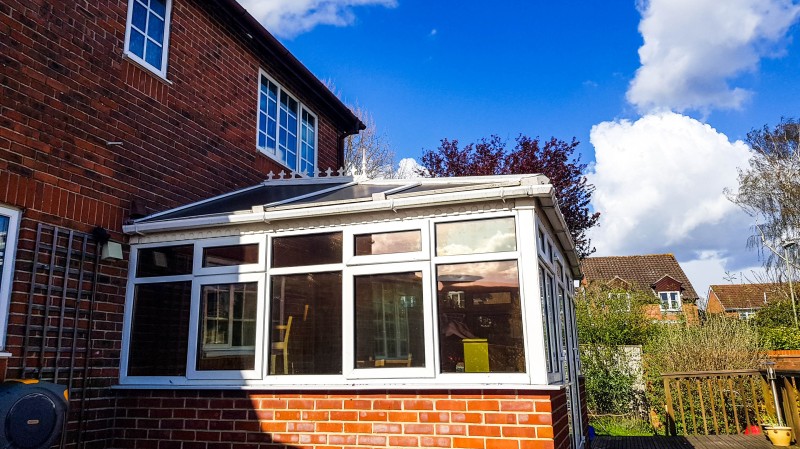You are here: Ways to make your conservatory more energy efficient and usable all year-round
Is retrofitting insulated panels a good idea?
Conservatories offer huge potential as light and airy additional living spaces. But they are often underused because of uncomfortable temperature extremes; tropical in summer and arctic cold in winter. When heat escapes through the conservatory roof, it can drive up energy costs. Insulating the structure is not only eco-friendly, reducing carbon emissions, but makes it a more usable space 365 days of the year while keeping money in your pocket.

Reducing heat loss in a conservatory
Problems with conservatories either being too hot or too cold are usually worse for older structures which may have been poorly built and without the benefit of modern glazing. There is a thriving market in retrofitting insulation systems to improve energy performance. Typically, they involve either covering or replacing the existing glass or polycarbonate roof with solid insulated panels to prevent over-heating in summer and heat loss in winter. Tailor-made to fit your existing conservatory framework, the installation is quick and relatively simple. Some will also replace the interior conservatory ceiling.
Alternatively, you can go down the DIY route, covering over the ceiling from the inside with a foil blanket or insulation layer which is attached to battens and then covered with plasterboard, retaining the external appearance.
Is it worth replacing the conservatory roof?
Some conservatories tacked on the back of houses are lightweight, flimsy structures with shallow foundations. This is because older conservatories were exempt from Building Regulations when they were built, so the quality of construction and importantly insulation, depended on the individual builder. Some uPVC frames have the cheapest, thinnest plastic panels while timber-frame conservatories may have areas of rot. While it’s possible to fit new roof panels onto a conservatory, whether it’s a wise investment is another matter. Ask a structural engineer for advice. Your conservatory might need some structural alterations to support a new roof, or it might be better to knock it down and start again. So, what are the options for a new conservatory roof? Most conservatory roof replacements don’t need planning permission but it’s always wise to check with your local council.
Polycarbonate conservatory roofs
The majority of standard conservatories come with a polycarbonate roof rather than glass. The thermoplastic is cheap to produce, lightweight and clear. Plus, it’s easy to mould into different shapes. A lighter alternative to glass, the material is UV compatible and can come with a coloured tint. Polycarbonate is used for everything from conservatory roofs to eyewear and bus shelters.
Pros
The main attraction of polycarbonate conservatory roofs is the price, being a lot cheaper than glass or solid tiles. If you are on a tight budget, it is a more affordable option.
Polycarbonate is considered almost unbreakable giving it a clear advantage over glass in safety. Plus, it can withstand extreme temperatures either hot or cold as well as sunlight, snow, rain and wind. Options include more transparent or opaque roof to regulate the light and temperature.
Cons
So, what’s not to like? Polycarbonate roofs provide very little heat or sound insulation. Heavy rain can reverberate off the hard plastic roof, creating a lot of noise. Depending on the weather, your conservatory may be either ice cold, boiling hot or deafening loud. That said, it’s possibly to buy inexpensive solar inserts for polycarbonate roofs that reflect the sun’s rays before they get into the conservatory - reducing heat build-up in summer.
Polycarbonate roofs can look a bit cheap and tacky, though clear plastic offers a more glass-like appearance. While the material can withstand heavy rainfall, polycarbonate panels may scratch easily and suffer from discolouration and leakage.
Glass roofs
Glass roofs are generally considered a more attractive option than polycarbonate roofing and better insulators, staying warmer in the winter months. If you like the conservatory vibe but want a classier, more energy efficient room, it’s possible to replace old glass or polycarbonate roofing with a modern, well-insulated glass roof, such as double – or even triple – glazing with argon filled cavities and thermal breaks between panes.
Pros
Glass roofs allow natural light to flood into the space below. Quality glass is durable, lasting 20-30 years without needing any replacement. What’s more it’s easy to install, so it won’t be difficult to find an installer.
Cons
Conservatory glass has improved but you may still have the greenhouse effect in summer and ice cube feel in winter. Blinds can minimise unwanted glare. Finishes are also available to reduce the sun’s rays, UV levels and heat, so it’s worth enquiring about them too. Glass can be expensive especially compared to polycarbonate. However, glass looks better and lasts longer.
Solid tiled roofs
Replacing polycarbonate or glass with a more solid tiled roof improves energy efficiency and reduces extremes of temperature. Less glass means less passive solar heating in summer while insulation in the roof keeps the space warmer in winter.
If you remove the link door and connect to your central heating system, the work will need to comply with Building Regulations. However, if you keep a quality external door between the house and conservatory and an independent heating system, this solution remains a conservatory under Building Regs.
Pros
A tiled roof will keep the conservatory cooler on sunny days and warmer in winter, so you’ll be more inclined to use it all year round. It will be quieter than glass or plastic when rain is hammering down. Plus, you won’t need to climb ladders to clean a dirty glass or clear plastic roof.
Externally tiles can be chosen to suit the style of your home, so your conservatory appears more like an extension. This option can be ideal whether you want a new office, dining space or additional living room, for example.
Adding a functional all-year-round room to your property will increase its value, especially if you are using it for more than hanging laundry and potential buyers can see that.
Cons
A new tiled roof is more expensive than adding a glass or polycarbonate structure. The building process is likely to take longer and be more complex. The conservatory is likely to need some structural alterations to support a tiled roof. It could well be that the foundations aren’t deep enough to carry the extra loads associated with a more solid structure. The way to tell this is by digging trial pit alongside the structure to measure the depth and size of existing foundations.
The downside to better temperature regulation is solid roofs let in less bright light and you can’t see the stars at night, though you could include some skylights. However, if you have large side windows and glass doors, you should still get plenty of side light.
With energy efficiency a higher priority for homeowners, it makes sense to consider ways to better insulate your conservatory. Get it right and you should be able to enjoy all the benefits, such as plenty of daylight and good garden views but with the added advantages of being able to control the temperature and extra all year-round usage.
If you are looking to make some home improvements, you may find some of these services useful
Building Regulations
Find details of local experts who can help with Building Regulations
Builders
Find local help with a building project
Architectural Design Services
Find local Architectural Design experts
Structural Inspections
Find an expert to carry out a structural inspection
Building Surveys
I want a local surveyor to do a Building Survey for me
Choose which Architectural service you require
If you are not sure which service you require, check out the options available...


